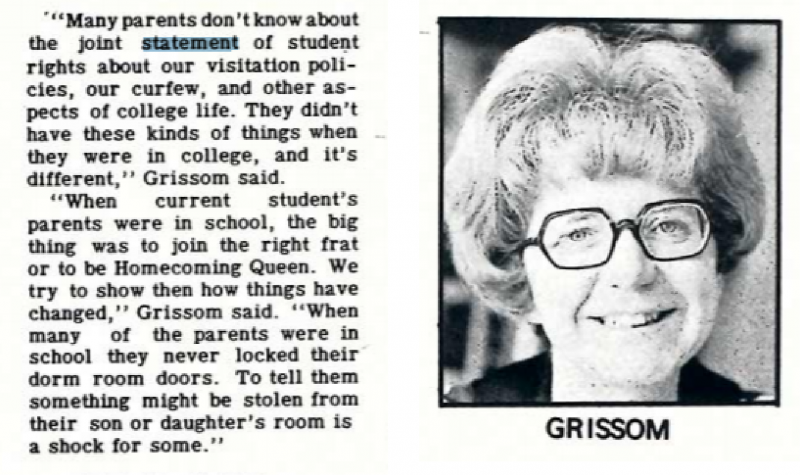Since its foundation in 1869, Trinity has undergone many changes, including in its guidelines for student life. Trinity’s earliest policies ensured freedom for the pursuit of education but left little room for other freedoms, such as what students wore and how they spent their time.
“[For women:] For fall and winter — Confederate gray flannel dresses trimmed with same. Hats of suitable style to match … For commencement — Cream mull dresses trimmed with cream lace. Trimming must not be elaborate. Cream hats,” according to the 1894 Courses of Study Bulletinn “The uniform adopted for young men consists of a dark blue for coats and a blue gray for pantaloons, of good material and made in seasonable college styles with caps to match the coat.”
In addition, church attendance and religious exercises were mandatory. The bulletin also stated that students were not allowed to acquire debts.
“[Today] there are fewer restrictions on students in terms of the clothing that they are wearing, fewer restrictions on hours and etc.,” said Meredith Elsik, senior reference assistant in Coates Library. “Nowadays, students have the ability to put a little bit more into the decisions that they make for themselves in comparison to when there were a lot stricter, more formalized regulations of what they had to do on campus. So I think it’s probably better.”
Coleen Grissom, professor of English, began working at Trinity in 1958 and has played a role in enforcing and reforming these rules as former vice president for Student Affairs. In addition, she was a head resident of a girls dormitory in the 1950s.
“The men had no rules. The women had a thousand. And they weren’t called women, they were called girls,” Grissom said.
The early editions of Courses of Study Bulletins did not even allow communication between members of the opposite sex. The rules detailed in handbooks became progressively less gendered in the ’70s.
“After the first semester of the freshman year, all resident women are designated as having ‘unrestricted privileges.’ These privileges place upon the student herself the responsibility for determining her own curfew and for signing out properly from her dorm,” according to the 1973-1974 Student Handbook.
Grissom recalls dreading having to go to upper campus because all women — not just students — were not allowed to wear pants or shorts there, only dresses and skirts. On lower campus, in certain areas and in the dorms clothing regulations were less severe. According to Grissom, Trinity’s rules were mainly enforced for women, such as curfew (before sundown, as early as 6 p.m. in 1869) and visitation hours, which were both intended to limit contact between men and women and inhibit any sexual relations.
Trinity’s female students also followed social codes that made sure they acted in a ladylike manner.
“It is not necessary to answer invitations for tea or coffee; however, if a resident cannot go she should write the hostess on the day of the tea or soon afterwards with a note of regret,” according to the Etiquette section of the 1968–1969 Handbook for Resident Women.
“What I can’t remember is how we ever changed it,” Grissom said. “It was a slow process.”
According to the various residential handbooks created over the years, students gained more personal freedoms, and the university no longer held students accountable as a parental authority. Along with Grissom, Ronald Calgaard played an important role in enacting change.
“[Arriving on campus in 1979], Calgaard directed the University Standards Committee to formulate new regulations for campus residence halls. The university began requiring students to sign an agreement that outlined their relationship as renters with the institution as landlord.” according to university historian Douglas Brackenridge in his book Trinity University: A Tale of Three Cities.
Students today can eat in their dorms and no longer sign in and out of dorms or to go off campus, nor do they have to request special permission or chaperones to do so. In the past, failing to follow these rules could result in punishment by what was known as “a campus,” meaning they were limited to three activities, going to class, meals and church, according to the 1951-1952 McFarlin Dormitory Handbook for Resident Women.
Over the course of the university’s history, rules on substance use have also changed; the rules have fluctuated between allowing, banning and regulating alcohol and tobacco — as is seen in present-day rules.
Nevertheless, many rules that existed at the time are still enforced today. Students still cannot hang laundry from windows and dorm balconies or move furniture between rooms. Older generations also had quiet hours, though theirs were more restrictive.
“Do not use typewriters in your room after 11:00 at night,” according to the 1951-1952 Mary Catherine Hall Handbook for Resident Women.
Visit Special Collections in Coates Library or access archives online through the Trinitonian website to learn more about Trinity’s old rules.







